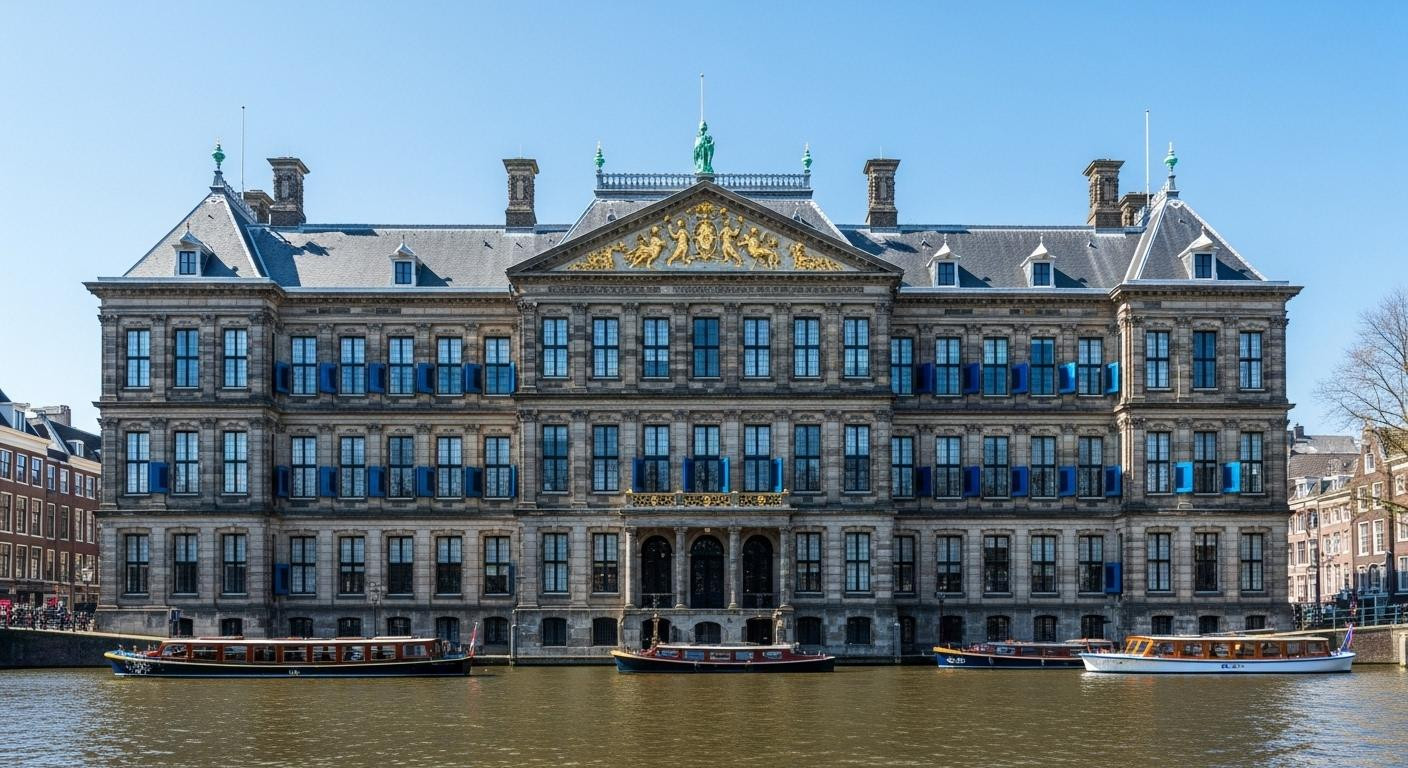Dawn mist rises from Prinsengracht canal at 6:47 AM as golden light touches the former Palace of Justice’s 1665 facade. Inside Rosewood Amsterdam, Studio Piet Boon’s restoration reveals courtyard gardens, Dutch craftsmanship details, and the soft greys and inky blues that mirror Amsterdam’s eternal sky. This May 2025 opening marks the last monumental building conversion permitted in the UNESCO canal district.
A once-in-a-generation transformation redefines luxury through Dutch gezelligheid philosophy. While 20 million tourists visit commercialized Amsterdam attractions, this 134-room sanctuary offers purpose-led luxury that transforms how travelers understand Dutch hospitality, historical reverence, and canal-district authenticity.
The 360-year palace that became Amsterdam’s most intimate luxury landmark
Approaching the UNESCO canal district location, the weight of history settles immediately. This 1665 architectural heritage spans from orphanage origins to Palace of Justice, abandoned in 2013, then reborn through a decade-long restoration. Studio Piet Boon’s philosophy preserved historic grandeur while introducing contemporary Dutch refinement.
The building originally served as an orphanage before becoming the Palace of Justice in 1829. Its abandonment in 2013 preceded Amsterdam’s 2024 ban on new hotel construction, making this the final permitted development within the city’s monumental buildings. Grand staircases and ornate tiles remain, while intricate woodwork, large windows, decorative ceilings, and granite columns tell centuries of stories.
Rooms range from 333-452 square feet, each uniquely configured due to the historic building’s original layout. These 5 luxury brands reveal what locals book when celebrating in Kyoto, Vienna, and Marrakech, yet Rosewood Amsterdam’s transformation creates something entirely different through architectural reverence.
What Rosewood Amsterdam transforms about Dutch hospitality
The revelation emerges through gezelligheid concept embedded in every design choice. Three distinctive restaurants and three distinct courtyards create intimate spaces where this historic landmark returns to Amsterdam residents through purpose-led luxury rather than ostentation.
Architecture that honors 1665 while creating 2025 comfort
Courtyard views span a glass-covered atrium, cozy terrace with fire pits and lounge seating, and open-air garden. Canal-facing rooms overlook UNESCO-protected waterways, while Dutch craftsmanship details appear in restored original flooring and woodwork. The blue and gray palette inspired by the city’s shifting skies creates visual continuity between interior and Amsterdam’s eternal atmosphere.
The cultural philosophy that separates this from palace hotels
Unlike traditional European palace hotels that emphasize grandeur, gezelligheid prioritizes welcoming and cozy atmosphere throughout venues. Local ingredient focus appears in the three restaurants, while community integration allows Amsterdam residents to experience their transformed landmark. This 330-soul French hilltop village costs half what Tuscany charges, demonstrating how authentic European experiences often cost less than tourist-saturated alternatives.
The Rosewood Amsterdam experience from courtyards to restaurants
Concrete guest experiences begin with courtyard garden walks through three distinct outdoor spaces. The glass-covered atrium provides year-round serenity, while the terrace with fire pits offers evening gathering spots. The open-air garden delivers Amsterdam canal district proximity to museums and markets.
Dining that elevates Amsterdam’s local-seasonal philosophy
Eeuwen restaurant anchors the dining experience with impeccable, charming, knowledgeable service presenting beautifully crafted local cuisine. The Advocatuur bar complements fine dining with Dutch gin selections. A third restaurant listed on MICHELIN Guide as Modern Cuisine rounds out the culinary offerings, though specific Michelin star status remains unverified.
The courtyards and spaces tourists never access
Private gardens reward slow discovery through architectural details preserved from the building’s 360-year history. Gallery space houses more than 1,000 contemporary and historic Dutch works, while an art vending machine provides unique cultural access. This Luxembourg valley costs half what Switzerland charges for 7 medieval castles, yet Rosewood Amsterdam’s artistic integration creates value through cultural immersion rather than pure spectacle.
Why spring 2025 marks the ideal Rosewood Amsterdam moment
The May opening timing coincided perfectly with spring tulip season, mild 63°F weather, and pre-summer crowds. This historic significance extends beyond seasonal advantages. Amsterdam’s 2024 ban on new hotel construction means this may be the last major hotel opening in the city for some time.
The hotel transforms luxury expectations through cultural authenticity rather than opulence. Recent visitor surveys from 2025 reveal that travelers increasingly seek purpose-led luxury that connects them to local heritage. I learned to make pasta in a 74-year-old nonna’s Tuscan kitchen – it changed how I cook demonstrates how authentic European cultural immersion through local traditions creates lasting transformative experiences.
Your questions about Rosewood Amsterdam answered
How does Rosewood Amsterdam compare to other European palace hotels?
Rates start from $1,430 compared to $1,100+ at Venice and Paris palace properties. The gezelligheid philosophy emphasizes welcoming atmosphere over traditional luxury ostentation. UNESCO canal district location provides exclusivity that commercial hotel districts cannot match.
What’s the best season to experience Amsterdam’s canal district?
Spring (April-May) offers tulip blooms and mild 48-63°F weather versus summer crowds. Autumn (September-October) provides golden light and cultural events with temperatures between 48-59°F. Tourist crowds remain moderate during both seasons compared to peak June-August periods.
Can non-guests experience the restaurants and galleries?
Public access allows Amsterdam residents and visitors to book restaurant reservations and gallery visits. Local tourism boards confirm the hotel welcomes community integration through its cultural programming. Advance reservations ensure access to Eeuwen restaurant and art exhibitions.
Evening light bathes the former Palace of Justice at 8:47 PM as courtyard lanterns glow softly. Inside, Dutch gin aromas from restaurant selections mingle with canal air. This is how Rosewood Amsterdam transforms luxury through 360 years of history meeting warm gezelligheid embrace.
